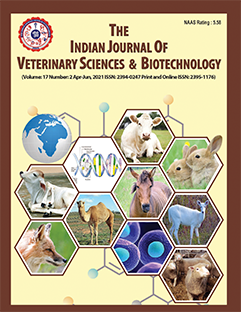Effect of Feeding Fortified Milk Replacer on Dry Matter Intake and Nutrient Utilization in Crossbred Dairy Calves
DOI:
https://doi.org/10.48165/ijvsbt.21.5.13Keywords:
Crossbred calves, Growth performance, Digestibility, Economics, Fortified milk replacerAbstract
The study was carried out to investigate the influence of fortified milk replacer on the growth performance and nutrient digestibility of pre-ruminant HF crossbred dairy calves. Fourteen male and female crossbred calves were allocated at random to two groups, T1 (Control) and T2 (Treatment), each having seven calves. The T1 group received whole milk for 120 days, whereas the T2 group was offered reconstituted fortified milk replacer with essential vitamins, minerals, amino acids, lysolecithin and probiotics to enhance nutrient utilization, fat digestibility and gut health. Calves were fed at a rate of 1/10th of body weight for the first six weeks, 1/15th for the next four weeks and 1/20th for the last two weeks, according to the feeding regimen. According to ICAR (2013) guidelines, both groups received green fodder (Hybrid Napier CO3) and a calf starter (23% crude protein, 70% TDN) during the trial. Unlimited access to fresh drinking water was provided. The two groups did not differ significantly (p>0.05) in terms of feed intake, growth performance, and digestibility of dry matter and crude protein. However, the T2 group showed a significantly higher (p<0.05) digestibility of ether extract, neutral detergent fibre and acid detergent fibre. Moreover, the cost of feed per kg body weight gain was notably lower (p<0.05) in the T2 group than in T1 group. In summary, fortified milk replacer demonstrated itself as a cost-effective option for rearing pre-ruminant crossbred calves, delivering similar growth and dry matter intake, along with enhanced nutrient digestibility, without compromising performance
Downloads
References
Abdullah, M., Iqbal, Z.M., & Saadullah, M. (2013). Comparative performance of calves fed milk and/or milk replacer supplemented with calf starter up to weaning age in Nili-Ravi buffaloes. Buffalo Bulletin, 32, 874-877.
Abhijith, M. (2022). Evaluation of milk replacers containing alternative protein sources in crossbred calves. M.V.Sc Thesis. Kerala Veterinary and Animal Sciences University, Pookode, India, p. 88.
AOAC [Association of Official Analytical Chemists]. (2016). Official Methods of Analysis (20th ed.). Association of Official Analytical Chemists, Washington DC, 1885p.
Bach, A., Terre, M., & Pinto, A. (2013). Performance and health responses of dairy calves offered different milk replacer allowances. Journal of Dairy Science, 96, 7790-7797.
Bharti, P.K., Kamboj, M.L., & Tyagi, A. (2012). Comparative effect of feeding commercial milk replacer and whole milk on growth performance and feed conversion efficiency for Indian dairy calves. Indian Journal of Animal Sciences, 82, 1221-1224.
Dar, A.H., Singh, S.K., Rahman, J.U., & Ahmad, S.F. (2022). The effects of probiotic Lactobacillus acidophilus and/or prebiotic mannan oligosaccharides on growth performance, nutrient utilisation, blood metabolites, faecal bacteria and economics of crossbred calves. Iranian Journal of Veterinary Research, 23(4), 322-330.
Godden, S. (2008). Colostrum management for dairy calves. Veterinary Clinics of North America: Food Animal Practice, 24(1), 19-39.
Godden, S.M., Fetrow, J.P., Feirtag, J.M., Green, L.R., & Wells, S.J. (2005). Economic analysis of feeding pasteurized non-saleable milk versus conventional milk replacer to dairy calves. Journal of the American Veterinary Medical Association, 226(9), 1547-1554.
ICAR [Indian Council of Agricultural Research]. (2013). Nutrient Requirement of Animals: Cattle and Buffalo (3rd ed.). Indian Council of Agricultural Research, New Delhi, p. 59.
Jadav, P.V., & Gaur, V. (2022). Effect of milk replacer on growth performance and economics of raising preweaned HF crossbred calves. The Indian Journal of Veterinary Sciences & Biotechnology, 18(5), 56-58.
Jaeger, B.M., Ziegler, D., Schimek, D., Ziegler, B., Raeth, M., Chester Jones, H., & Casper, D.P. (2020). Growth performance of newborn dairy calves fed a milk replacer with 2 protein concentrations at 2 feeding rates. Applied Animal Science, 36(1), 48-56.
Jaster, E.H., McCoy, G.C., & Fernando, R.L. (1990). Dietary fat in milk or milk replacers for dairy calves raised in hutches during the winter. Journal of Dairy Science, 73(7), 1843-1850.
Kamalahasan, K. (2018). Evaluation of performance of crossbred calves under different feeding systems. M.V.Sc Thesis. Kerala Veterinary and Animal Sciences University, Pookode, India, p. 75.
Nageshwar, A., Raval, A.P., Bhagwat, S.R., & Rajgor, B.B. (2016). Studies on growth, nutrient utilization, immune modulation and economic return at different levels of probiotic feed supplementation in Kankrej female calves. Animal Science Reporter, 10(2), 55-62.
NRC [National Research Council]. (2001). Nutrient Requirements of Dairy Cattle (7th ed.). National Academy Press, Washington, DC, 363p.
Priestley, D., Bittar, J.H., Ibarbia, L., Risco, C.A., & Galvão, K.N. (2013). Effect of feeding maternal colostrum or plasma-derived or colostrum-derived colostrum replacer on passive transfer of immunity, health, and performance of preweaning heifer calves. Journal of Dairy Science, 96(5), 3247-3256.
Reis, M.E., Toledo, A.F.D., da Silva, A.P., Poczynek, M., Fioruci, E.A., Cantor, M.C., ... & Bittar, C.M.M. (2021). Supplementation of lysolecithin in milk replacer for Holstein dairy calves: Effects on growth performance, health, and metabolites. Journal of Dairy Science, 104(5), 5457-5466.
Shukla, R., Shah, S.V., Pandya, P.R., Lunagariya, P.M., Pandya, S.S., & Divekar, B.S. (2017). Effect of feeding milk replacer on dry matter intake and feed efficiency in Holstein x Kankrej crossbred calves. The Indian Journal of Veterinary Sciences and Biotechnology, 12, 105-111.
Snedecor, G.W., & Cochran, W.G. (1994). Statistical Methods (8th ed.). The Iowa State University Press, Ames, Iowa, USA, 503p.
Suresh, D. (2022). Assessment of performance of pre-ruminant crossbred calves maintained on different feeding strategies. M.V.Sc Thesis. Kerala Veterinary and Animal Sciences University, Pookode, India, p. 88.
Thornsberry, R.M., Wood, D., Kertz, A.F., & Hutcheson, D. (2016). Alternative ingredients in calf milk replacer: A review for bovine practitioners. The Bovine Practitioner, 50(1), 65-88.
Van Soest, P.V., Robertson, J.B., & Lewis, B.A. (1991). Methods for dietary fiber, neutral detergent fiber and non-starch polysaccharides in relation to animal nutrition. Journal of Dairy Science, 74(10), 3583-3597.
Downloads
Published
Issue
Section
License
Copyright (c) 2025 Indian Journal of Veterinary Sciences and Biotechnology

This work is licensed under a Creative Commons Attribution-NonCommercial-NoDerivatives 4.0 International License.




